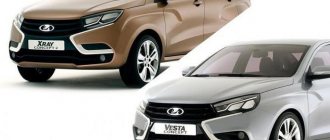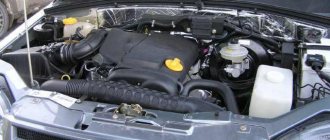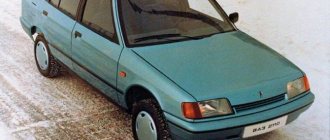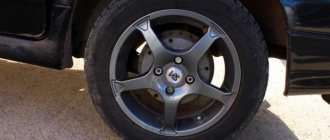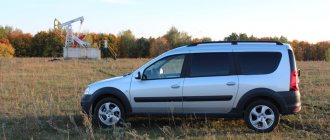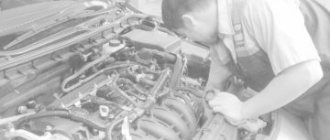Production history
Serial production of the VAZ Niva 21213 began in 1977.
The most eminent design engineers of the USSR were involved in the development of this SUV. Probably, it was the unity of all the actions of the design bureau workers that made it possible to create a car characterized by high cross-country ability, light weight and unpretentious maintenance. VAZ Niva 21213 is the first car in the history of the domestic automotive industry that was created specifically for off-road driving, traveling to the most inaccessible places, as well as for fishing and hunting trips. All this was facilitated not only by all-wheel drive and a powerful gasoline engine for those times, but also by a practical body layout - a folding rear seat made it possible to place various household goods weighing up to several hundred kilograms inside the Niva.
Lada 4×4 3D SAMOVAR › Logbook › Performance characteristics of Niva 21213 - before and after, let’s compare
This BZ will be a kind of summary, a summary of all changes in numbers.
I undertake to include here, as much as possible, with all possible instruments, data that reflects changes in the car, including subjective sensations.
Basic data
1. Number of seats - 5 2. Length - 3720 mm 3. Width - 1680 mm 4. Height - 1640 mm 5. Wheelbase - 2200 mm 6. Front wheel track - 1430 mm 7. Rear wheel track - 1400 mm 8. Ground clearance - 220 mm 9. Trunk volume - 265 / 980 l 10. Curb weight - 1210 kg 11. Permissible weight - 1610 kg 12. Fuel consumption per 100 km, no more than, l: - on the highway at a speed of 90 km/h in fifth gear 8.3 - on the highway at a speed of 120 km/h in fifth gear 11.5 - in the urban cycle 10.3
1. Vehicle ground clearance with VLi-10 tires (175/80R16)
• to the cross member of the front suspension 221 mm •
became 250 mm
• to the rear axle beam 213 mm •
became 245 mm
4. Power sills
• made of pipe with Alligator painting, plus linings made of corrugated aluminum
5. Suspension lift
• suspension was lifted in 2 stages - the first and the second, but there are still improvements
6. Beginning of styling
• I applied the company logo to the car, but I think I’ll redo it... I was wrong with the proportions • front aluminum power bumper with LED PTF • rear power bumper with a gate • applied the logo of the same size to the other side, Well, a sticker with more information on the rear window
8. The brakes are fixed
•
completely replaced with new ones with copper tubes
9. The exhaust is welded to the side
•
redone twice, I hope the second time is final
10. Unloaded axle shafts and Blok blocking from Izh-Techno
•
everything is installed and working
11. Complete maintenance of the car April 2021
• including the internal combustion engine, transmission and body
12. Winch
• light winch from a quad with a stainless steel platform, only 8 kg together.
14. Wheel spacers 16 mm
15. Subframe of the gearbox and gearbox on silent blocks, + third support for the gearbox
• I completed the subframe, now both the gearbox and gearbox hang on it, the gearbox has a 3rd support
Source
Domestic Range Rover?
What unites the domestic VAZ 2121 with the British Rover? At first glance, absolutely nothing. However, you just have to take a closer look at the technical part, and everything will become clear. The fact is that the Niva used a non-disconnectable drive on all four wheels with a transfer case and a locking center differential. This is exactly what the British Range Rover had in the 70s. Thanks to such equipment, the domestic SUV could easily overcome fords, ravines and other off-road conditions. At that time, the new Soviet jeep had no analogues in terms of cross-country ability and comfort.
Equipment and comfort
At first glance, the VAZ Niva 21213 is the Volga analogue of the Ural UAZ 469 model. Yes, in terms of driving performance and cross-country ability they are almost Siamese twins, but inside they are completely different. The front row of seats has headrests, the backrest is adjustable in length and angle, the rear row folds to increase luggage space. Upon request, the Niva was equipped with a rear window washer and cleaner, as well as an electric window heater. By today's standards, the equipment of the Volga SUV is almost ascetic, but in the 70s they did not even dream of such luxurious things.
VAZ Niva 21213: technical specifications
Initially, the car was equipped with a 4-cylinder carburetor engine with a volume of 1.6 liters. Next came new modifications, as a result of which a 1.3-liter engine was added to the line of power plants, but it was not particularly popular among car enthusiasts.
As for the gearbox, the Niva was equipped with a four-speed manual gearbox with synchronizers in the forward gear. A little later, the SUV began to be equipped with a more advanced transmission - 5 steps. Don’t forget about the transfer case, which allowed the SUV to overcome any off-road conditions. The two-stage transfer case with center differential had a forced lock. The cardan transmission consisted of cardan shafts of the rear and front axles, as well as an intermediate shaft.
The suspension also had its own technical features. The front was independent, on wishbones with hydraulic shock absorbers, springs and a stabilizer bar, which prevented the car from tipping over when cornering. The rear suspension is dependent, with coil springs, one transverse rod and four longitudinal ones. Like the front one, it was equipped with several hydraulic shock absorbers.
Chassis
At the front, the car has an independent suspension with anti-roll bar. At the rear there is an axle with coil springs and telescopic shock absorbers. Brakes – hydraulic, with booster. Disc mechanisms are installed at the front, drum mechanisms at the rear. The steering mechanism is a gearbox with hydraulic booster.
How does this car behave on the move? The suspension is surprisingly quite soft. Moreover, it works more smoothly than on the three-door short-wheelbase version. Irregularities are handled well, but suspension knocks are still heard inside. There are also questions about handling. At a speed above a hundred, the car begins to scour the road. And there is no need to talk about comfort - you can hear the roar of the engine inside. Therefore, this suspension is excellent only for rough terrain.
The first modernization of a domestic SUV
Oddly enough, the first modernized Niva model went into mass production only 16 years later. Moreover, practically nothing has changed in the technical part of the car - all the parts and assemblies are from 1977! The exception was the new internal combustion engine, but more on that a little later.
The main changes affected only the external appearance of the Niva. The new modification is distinguished by a more elongated body and slightly modified brake lights at the rear. By the way, the trunk lid could now only be opened from the passenger compartment. The bumper remains metal, but is now painted light gray. In general, the exterior of the car is not particularly sophisticated or cool. However, today's off-road tuning of the VAZ 21213 (Niva), which consists of installing power bumpers, snorkels, new wheels and other units, can significantly modernize the appearance of the car.
Inside, the changes were also minimal - the seats and instrument panel became similar to Ladovian ones (from the VAZ 2108). What do the owners say? According to reviews, the Niva 21213 became more comfortable after modernization, but the designers still could not avoid the old shortcomings (distortions of the back and constant noise inside).
And now about the technical part. Since the beginning of 1993, the modernized version of the Niva has been equipped with a new gasoline engine with an increased displacement - up to 1.7 liters. For the first time, a contactless ignition system was used on an SUV. The carburetor was also changed. The braking system has been improved. The main gear of the gearbox now has a gear ratio of 3.9. The muffler has also undergone minor changes. Now its body is not welded, as before, but rolled (like the Lada of the eighth model).
As practice shows, new improvements in the internal combustion engine and transmission system have made it possible to significantly reduce fuel consumption on the VAZ Niva 21213 SUV. So, per “hundred” the car spends about 13 liters in the city and up to 11 liters on the highway.
Export versions of the Niva had central fuel injection and were equipped with a non-disconnectable wheel drive with a center differential and a transfer case with a reduction row. At the request of the customer, the car could be equipped with a French diesel engine from Peugeot with a displacement of 1.9 liters. But, unfortunately, these were only isolated cases.
Niva 2131: technical characteristics of a 5-door car
Return to contents
Dimensions, weight, load capacity
The vehicle has characteristics such as length, width, height. These indicators help the driver assess how much space the car occupies on the road. Length is the distance between the maximum protruding parts in front and behind. The width is determined by the boundaries of the side mirrors. Height is measured from the surface on which the vehicle is located to the highest point on the roof of the vehicle.
All this data is not difficult to find in the vehicle operating manual. Dimensions Niva 2131:
For Niva 2131, the outer minimum turning radius along the axis of the front wheel track is 6.45 m. Equally important indicators are weight (curb weight) and load capacity. The first is the total mass of a set of standard equipment, all necessary consumables (including engine oil, fuel, etc.), as well as the weight of the driver. Baggage and passengers are not included. The 5-door Lada Niva 4x4 weighs 1370 kg.
Payload capacity is the difference between the permissible maximum weight and the curb weight. For Lada Niva 2131, the first indicator is 1870 kg, therefore, the carrying capacity of this vehicle is 500 kg. Permitted maximum weight (PMM) is calculated as the sum of the curb weight of the car and the maximum total weight of luggage and passengers (in the amount provided for by the design).
Return to contents
Custom Options
Technical characteristics of the Niva 2131 include operational features, engine properties and fuel and speed parameters.
Basic data on the model under consideration are presented in the table:
| Body type | all-metal, monocoque, 5-door station wagon |
| Body class | SUV |
| Layout diagram | all-wheel drive, longitudinal engine |
| Number of places, people | 5, with the rear seat backs folded – 2 |
| Trunk volume, l | 420, with seats folded – 780 |
| Transmission type | 5MT |
| Wheelbase, mm | 2700 |
| Front/rear wheel track, mm | 1440/1420 |
| Front/rear brakes | Disc/drum |
The vehicle ground clearance (clearance) with a static tire radius of 314 mm (185/75R16) is:
For a 4x4 vehicle, the wheels account for 100% of the weight. That is why an all-wheel drive vehicle has a traction force that is approximately 2 times greater than a vehicle with a 4x2 wheel arrangement. Thanks to the front wheels installed at certain angles relative to the body parts and suspension, this car has good stability and controllability. A special feature of the 2131 model is that it prohibits towing a trailer. The motor parameters have the following characteristics:
According to the operating manual, the maximum engine oil consumption is 0.7 liters per 1000 km. This value indicates wear of engine parts and the need for repairs.
Fuel and speed characteristics of the Lada Niva 2131:
In terms of technical characteristics, the Lada Niva 2131 is not inferior to its more expensive analogues.
Return to contents
Car exterior
Since the start of production of the car, its appearance has remained virtually unchanged. In modern vehicle design, a square body shape, round headlights, and laconic bumpers are a classic option. This model has rear doors on the left and right sides. This makes it easier for passengers to board and disembark. The increased wheelbase increased the smoothness of the ride and reduced swaying around the horizontal transverse axis.

